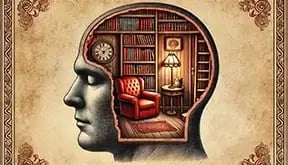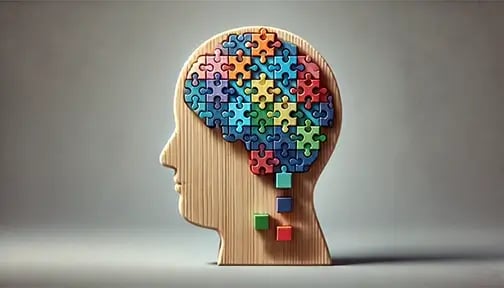Memorization is often seen as a tedious task, but what if you could turn it into an engaging and powerful mental exercise? The Memory Palaces technique, also known as the Method of Loci, has been used for thousands of years by scholars, storytellers, and memory champions to store and recall vast amounts of information with ease. This ancient technique transforms your mind into a virtual library, allowing you to retain information more effectively.
In this blog post, we'll explore what a Memory Palace is, how it works, and how you can use it to supercharge your memorization skills. Whether you're a student, teacher, home educator, or simply someone looking to boost your memory, this guide will help you master the art of storing knowledge in your mind.
What Is a Memory Palace?
A Memory Palace is a mental visualization technique that helps you store and retrieve information by associating it with a familiar location. The idea is to mentally walk through a place you know well—like your home, school, or workplace—while "placing" pieces of information in specific locations. Later, when you need to recall that information, you simply retrace your mental steps, picking up the details along the way.
The Memory Palace technique was first recorded in Ancient Greece and was famously used by Cicero, the Roman orator, to remember his speeches. Today, memory champions use it to recall long lists of numbers, historical dates, or even entire books.
How Does the Memory Palaces Technique Work?
The core principle behind this technique is association. By linking new information to something familiar—such as a room, a piece of furniture, or a specific spot in a building—you create strong mental cues that trigger recall.
Here’s a step-by-step guide to building your own Memory Palace:
Step 1: Choose Your Palace
Pick a location you know extremely well—your home, school, workplace, or even a route you walk every day. The more detailed and familiar the place is, the better.
Step 2: Define a Path
Mentally map out a fixed route through this location. For example, if you're using your house:
- Start at the front door
- Move into the living room
- Walk past the sofa
- Enter the kitchen
- Look at the dining table
- Go upstairs to the bedroom
This predefined path ensures that your mind follows a logical order when recalling information.
Step 3: Assign Information to Locations
Now, attach each piece of information to a specific place along your route. Make it visual, exaggerated, and unusual—the more bizarre, the better!
For example, if you're memorizing a list of famous scientists:
- At the front door, imagine Albert Einstein knocking with an electric zap of lightning around him.
- In the living room, see Marie Curie pouring a glowing green liquid on the sofa.
- In the kitchen, visualize Isaac Newton dropping apples into a blender.
This process of visual association strengthens memory retention.
Step 4: Walk Through Your Memory Palace
To recall the information, simply mentally walk through your Memory Palace, picking up details as you pass each spot. Since our brains are wired to remember locations and experiences, you’ll find it much easier to retrieve the information.
Why Does the Memory Palace Technique Work?
The effectiveness of the Memory Palace lies in how the brain processes information.
Spatial Memory is Stronger Than Rote Learning
- Humans naturally remember places and experiences better than abstract information.
- This technique taps into the hippocampus, the brain's center for spatial navigation and memory.
Visual and Emotional Cues Improve Recall
- A boring fact is easy to forget, but a crazy, exaggerated mental image is hard to erase!
- Using funny, shocking, or absurd visuals makes information stick better.
Engages Multiple Senses
- When you imagine a scene, you see, hear, and even "feel" the setting, making it more immersive.
Practical Uses of the Memory Palace
This technique isn’t just for memory champions—it can help in everyday life, too. Here’s how different people can use it:
For Students
- Memorize historical events by placing them along a familiar street.
- Learn math formulas by storing them in different rooms.
- Prepare for exams by organizing study material within a Memory Palace.
For Teachers & Home Educators
- Teach students how to build their own Memory Palaces for better retention.
- Use storytelling and visualization to help kids remember complex concepts.
For Professionals
- Recall names and faces by associating them with memorable locations.
- Memorize speeches or presentations without needing notes.
- Store key business facts in a structured mental format.
Advanced Memory Palace Techniques
Once you’ve mastered the basics, you can take it a step further:
1. Multiple Palaces
Use different Memory Palaces for different subjects—one for science, another for history, etc.
2. Expand Your Route
Add more locations, using outdoor settings, office spaces, or even fictional places.
3. Use a Peg System
Combine the Memory Palace with mnemonic pegs (like rhyming numbers: "one is a bun, two is a shoe") for even stronger recall.
4. Turn It Into a Story
Link all your visual images into a narrative, making recall even smoother.
Enhancing Your Memory Palace with Flash Cards
While the Memory Palace technique is powerful on its own, combining it with physical flash cards can reinforce retention even further. Writing down key facts on durable, color-coded flash cards and placing them in strategic locations around your home creates a real-world extension of your mental palace. This technique is especially useful for students, teachers, and lifelong learners who benefit from multi-sensory learning. Check out our Debra Dale Designs Astrobright Flash Cards—perfect for reinforcing memory techniques, studying complex subjects, and organizing information efficiently.
Final Thoughts: Build Your Own Mind’s Library
The Memory Palace technique is a powerful tool that transforms the way we learn and retain information. By leveraging spatial memory, visualization, and storytelling, you can turn complex information into an easy-to-recall mental journey.
Ready to Try It?
- Pick a familiar location today.
- Assign a list of items to specific spots.
- Walk through your Memory Palace and test your recall!
With practice, your mind will become a well-organized library where knowledge is always within reach.




